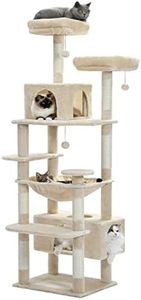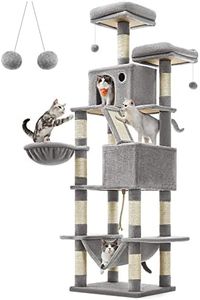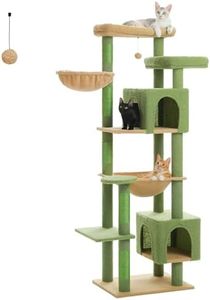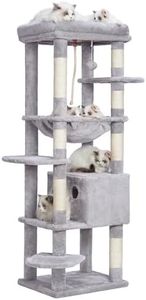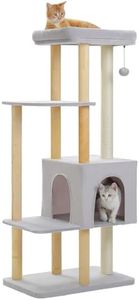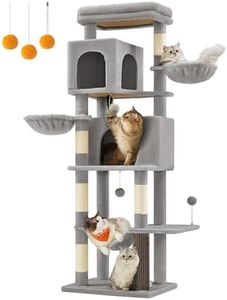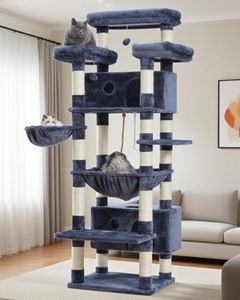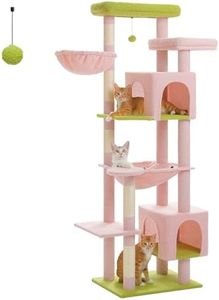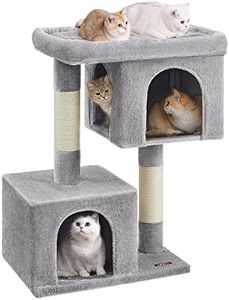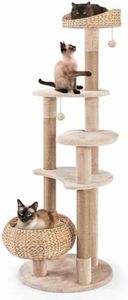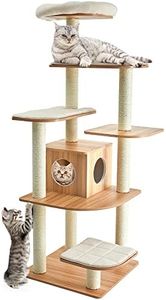We Use CookiesWe use cookies to enhance the security, performance,
functionality and for analytical and promotional activities. By continuing to browse this site you
are agreeing to our privacy policy
10 Best Cat Trees For Large Cats
From leading brands and best sellers available on the web.Buying Guide for the Best Cat Trees For Large Cats
Choosing the right cat tree for large cats is all about ensuring safety, comfort, and engagement for your feline friend. Large cats need sturdy, stable, and spacious furniture that supports their size and encourages healthy climbing, scratching, and lounging. When evaluating cat trees, it's important to look beyond appearance and focus on factors that impact durability and usability for bigger breeds or heavier cats. By carefully comparing key features, you'll find a product that keeps your cat happy and your home scratch-free.Stability and Base SizeStability is crucial for large cats as they exert more force when they jump and play. The base of the cat tree should be broad and heavy to prevent wobbling or tipping over. Cat trees with a wide, sturdy base are ideal for big breeds as they offer better balance. When comparing cat trees, make sure the base is at least as wide as your cat is long, and avoid models with narrow or lightweight supports. If you have multiple large cats or particularly energetic ones, opt for the sturdiest possible foundation.
Material and Construction QualityThe quality of the materials and construction determines how well a cat tree will withstand weight and use over time. Look for solid wood, thick posts, or reinforced panels rather than low-density particle board or flimsy plastics. The sturdier the materials and the more robust the assembly, the safer it will be for heavier cats. Test by gently shaking the tree or checking how much weight the manufacturer claims it can hold. If your cat is exceptionally large or you expect rough play, prioritize models built with reinforced hardware and premium fabrics.
Post DiameterThe scratching posts on a cat tree serve both as climbing aids and exercise opportunities. For large cats, the diameter of posts matters a lot: thin posts can bend or break under their weight, while thicker posts offer strong, reliable support. Generally, posts of at least 3.5 inches in diameter are better for bigger cats. If your cat enjoys climbing, or if you have multiple heavy cats, opt for the thickest posts available to ensure stability and longevity.
Perch and Platform SizePerches and platforms are where cats love to lounge and nap. Large cats need wider, longer, and sturdier surfaces to rest comfortably without hanging over the edges. When browsing cat trees, look for platforms that are at least 16 inches across; hammocks or perches with thick, supportive bases are also ideal. If your cat likes to spread out or if you want multiple cats using a single tree, prioritize wider perches and platforms.
Height and LevelsThe height and number of levels on a cat tree provide stimulation and help satisfy your cat's natural climbing instincts. While taller trees offer more excitement, they also need to be extra sturdy for heavy cats. Divide available cat trees into low (under 3 feet), medium (3–5 feet), and tall (over 5 feet) segments. Low trees can be good for older or less agile cats, medium is typically a safe and accessible height for most, and tall trees are best if your space and ceiling allow, provided you are sure of the stability.
Scratch Material and CoverageMost cat trees are wrapped in carpet, sisal, or other scratching materials to entice scratching. Sisal is especially durable and satisfying for large cats, while some prefer carpet for comfort. The more of the tree that is covered in scratchable material, the better. For cats that love to scratch, maximize the number and length of posts wrapped in thick, high-quality sisal to keep them engaged and away from your furniture.
Enclosures and HideoutsEnclosed spaces or hideouts can help a cat feel secure. For large cats, make sure these cubbies or condos are spacious enough for your pet to turn around and stretch out comfortably. Small, cramped spaces aren’t enjoyable for a big cat; look for enclosures with at least 12”x16” interiors. If your cat enjoys cozy hiding spots, large cubbies are a must-have.
